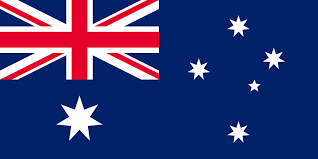
Indigenous Australians inhabited the continent for about 65,000 years[14] prior to the first arrival of Dutch explorers in the early 17th century, who named it New Holland. In 1770, Australia's eastern half was claimed by Great Britain and initially settled through penal transportation to the colony of New South Wales from 26 January 1788, a date which became Australia's national day. The population grew steadily in subsequent decades, and by the time of an 1850s gold rush, most of the continent had been explored by European settlers and an additional five self-governing crown colonies established. On 1 January 1901, the six colonies federated, forming the Commonwealth of Australia. Australia has since maintained a stable liberal democratic political system that functions as a federal parliamentary constitutional monarchy, comprising six states and ten territories.
Australia is the oldest,[15] flattest,[16] and driest inhabited continent,[17][18] with the least fertile soils.[19][20] It has a landmass of 7,617,930 square kilometres (2,941,300 sq mi).[21] A megadiverse country, its size gives it a wide variety of landscapes, with deserts in the centre, tropical rainforests in the north-east, and mountain ranges in the south-east. Australia generates its income from various sources, including mining-related exports, telecommunications, banking, manufacturing, and international education.[22][23][24]

Australia is a highly developed country, with the world's 14th-largest economy. It has a high-income economy, with the world's tenth-highest per capita income.[25] It is a regional power and has the world's 13th-highest military expenditure.[26] Immigrants account for 30% of the population,[27] the highest proportion in any country with a population over 10 million.[28] Having the third-highest human development index and the eighth-highest ranked democracy globally, the country ranks highly in quality of life, health, education, economic freedom, civil liberties, and political rights,[29] with all its major cities faring well in global comparative livability surveys.[30] Australia is a member of the United Nations, G20, Commonwealth of Nations, ANZUS, Organisation for Economic Co-operation and Development (OECD), World Trade Organization, Asia-Pacific Economic Cooperation, Pacific Islands Forum, and the ASEAN Plus Six mechanism.
The name Australia (pronounced /əˈstreɪliə/ in Australian English[31]) is derived from the Latin Terra Australis ("southern land"), a name used for a hypothetical continent in the Southern Hemisphere since ancient times.[32] When Europeans first began visiting and mapping Australia in the 17th century, the name Terra Australis was naturally applied to the new territories.[N 5]
Until the early 19th century, Australia was best known as "New Holland", a name first applied by the Dutch explorer Abel Tasman in 1644 (as Nieuw-Holland) and subsequently anglicised. Terra Australis still saw occasional usage, such as in scientific texts.[N 6] The name Australia was popularised by the explorer Matthew Flinders, who said it was "more agreeable to the ear, and an assimilation to the names of the other great portions of the earth".[38] Several famous early cartographers also made use of the word Australia on maps. Gerardus Mercator (1512–1594) used the phrase climata australia on his double cordiform map of the world of 1538, as did Gemma Frisius (1508–1555), who was Mercator's teacher and collaborator, on his own cordiform wall map in 1540. Australia appears in a book on astronomy by Cyriaco Jacob zum Barth published in Frankfurt-am-Main in 1545.[39]
Human habitation of the Australian continent is known to have begun at least 65,000 years ago,[45][46] with the migration of people by land bridges and short sea-crossings from what is now Southeast Asia.[47] The Madjedbebe rock shelter in Arnhem Land is recognised as the oldest site showing the presence of humans in Australia.[48] The oldest human remains found are the Lake Mungo remains, which have been dated to around 41,000 years ago.[49][50] These people were the ancestors of modern Indigenous Australians.[51] Aboriginal Australian culture is one of the oldest continual cultures on earth.[52]
Surrounded by the Indian and Pacific oceans,[N 7] Australia is separated from Asia by the Arafura and Timor seas, with the Coral Sea lying off the Queensland coast, and the Tasman Sea lying between Australia and New Zealand. The world's smallest continent[112] and sixth largest country by total area,[113] Australia—owing to its size and isolation—is often dubbed the "island continent"[114] and is sometimes considered the world's largest island.[115] Australia has 34,218 kilometres (21,262 mi) of coastline (excluding all offshore islands),[116] and claims an extensive Exclusive Economic Zone of 8,148,250 square kilometres (3,146,060 sq mi). This exclusive economic zone does not include the Australian Antarctic Territory.[117] Apart from Macquarie Island, Australia lies between latitudes 9° and 44°S, and longitudes 112° and 154°E.
Australia's size gives it a wide variety of landscapes, with tropical rainforests in the north-east, mountain ranges in the south-east, south-west and east, and desert in the centre.[118] The desert or semi-arid land commonly known as the outback makes up by far the largest portion of land.[119] Australia is the driest inhabited continent; its annual rainfall averaged over continental area is less than 500 mm.[120] The population density, 3.2 inhabitants per square kilometre, although a large proportion of the population lives along the temperate south-eastern coastline.[121]